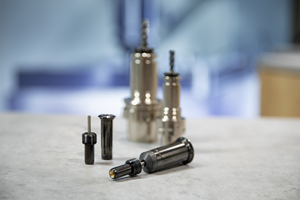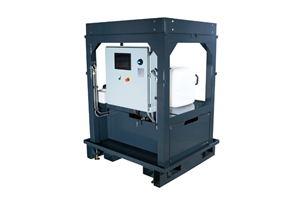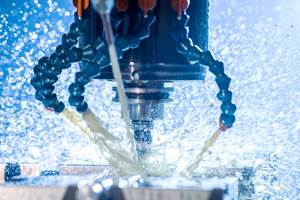Considerations for Machining Coolant Care
Coolant care can be simply managed if you know where to pay attention and which hazards to look out for.
Share





Reader Question: We struggle to make coolant last in our machines as long as we think it should. We’ve tried a few brands but no luck. The typical signs are poor finishes and awful smell towards the end of its life. We occasionally struggle with foaming as well. What is your advice to help us get more out of each fill?
Miller’s Answer:
Coolant care is not the most exciting of topics. While it’s way more fun to discuss new roughing strategies or programming techniques, coolant is uniquely important in that we touch it nearly every cycle when we remove a fresh part. If we’re honest, it’s in the air we’re breathing in our shops too. We have a responsibility to ourselves and our team to keep it in top shape, free from filth, bacteria and all the other issues that can be associated with it. Despite the potential hazards, however, its care can be simply managed if you know where to pay attention. For starters, you should be monitoring water quality for a good emulsion, concentration so it doesn’t get too high or low, and cleanliness.
Like most things that are put into a process, junk in will result in junk out, so it’s important to start right. When you mix fresh coolant, you want to make sure you’re using good water. If the water is coming from a deteriorating pipe or has a lot of haziness and sediment, you’re not off to a good start. Try to find a new source or make the repairs needed at the shop to solve this issue. While many coolants are formulated to work with hard or soft water, they aren’t meant to dissolve a lot of particulate.
Along the same lines, you’re probably checking the coolant concentration when you fill the machine, but you should also check concentration of your coolant frequently as it comes out of the machine. This shows the quality of coolant the part and tool is actually receiving as compared to what you just filled it with. I prefer to do this at the coolant nozzle by closing the door, running the coolant, stopping it, then reaching in and catching the last drops with the refractometer. By doing it here, versus in the tank, you can understand if the mix matches expectations or it is maybe separating over time. Coolant can separate from water from excess heat, high pressures and high rpm’s. Higher quality coolants tend to handle these things better and maintain consistent concentration longer.
Once overlooked, use of the refractometer is not just the coolant concentration, but also the cleanliness of the emulsion. For example, if the line you see is really crisp, its clean coolant. If the line is blurry or hazy, the coolant has too much tramp oil, dirt or other particulate affecting the reading. You should see a perfectly clean line when mixing fresh coolant from the drum, but you may start to see a hazy line when you take the reading from coolant that has already been in the machine. Track this over time and compare it to your current known coolant life to track progress on your efforts.
Tramp oil is the stuff you see floating at the top of your tank. Things like way lube, spindle oil or small hydraulic leaks make their way to the coolant tank over time. A coolant skimmer would be useful here to combat this problem and extend your life.
Another source of issues might be the parts you run. For example, dusty cast iron, material sitting in your shelves for a decade or the residual dirt from your saw cutting will all make their way into your coolant tank over time. When reasonable, it might be a good idea to give these a quick wipe before loading them into your vise and power washing them with your coolant system.
With regards to foaming, there at two primary causes for it: mechanical and chemical. Both require agitation to start the foaming process (simply churning the coolant when you start a cycle). Mechanical foaming is simply your coolant being over-churned, and it goes away quickly when you stop a cycle. You can slow down the flow with valves on the machine to tune this in and eventually get rid of it. Chemical foaming once started will not go away easily on its own as there is a problem with the emulsion causing it. This may be caused by water quality and can sometimes be fixed with additives. I highly recommend you consult your supplier and let them offer the best course of action as some additives may not be the solution or compatible with your setup. If you want a quick test to identify which one of it, take an empty water bottle and take a small sample from the tank. Shake it to agitate it. If it goes away, it’s likely mechanical. If not, it’s chemically related.
The last point on coolant care is to treat your coolant tank like you would a natural water source. A pond gets scummy overtime when the water doesn’t move, but a flowing stream or water fall stays fresh. This same idea works for the coolant tank. When you’re not using the machine, you can find ways to keep it moving in the tank so it doesn’t become stagnant. I utilize fish tank bubblers on the clean and dirty side of the tank just to keep the top surface of the coolant moving. It’s worked well for me thus far, in addition to the remedies mentioned before.
Do you have a machining question? Ask the expert. John Miller leans on more than a decade of industry experience to answer machining questions from MMS readers. Submit your question online at mmsonline.com/MillersEdge.
Related Content
Rego-Fix Toolholding System Reduces Coolant Consumption
MQL PG collets are designed for machines using one-channel, internal through-spindle MQL systems.
Read More168 Manufacturing's Coolant System Automates Delivery
PMTS 2023: FullShop systems monitor and replenish all CNC machine sumps with optimized top-off ratios before the coolant runs low.
Read MoreFortech Synthetic Coolant Enables Bio-Stable Metal Removal
Fortech’s TechKool FT4000 synthetic coolant is formulated to reject tramp oil that can cause smoking or misting and premature spoilage of coolant.
Read MoreHenkel Redefines Industrial Machining and Grinding with Sustainable Metalworking Innovation
With innovative formulation and bio-resistant properties, Henkel’s new semi-synthetic lubricant emerges as a pioneering solution in the machining industry.
Read MoreRead Next
Registration Now Open for the Precision Machining Technology Show (PMTS) 2025
The precision machining industry’s premier event returns to Cleveland, OH, April 1-3.
Read MoreBuilding Out a Foundation for Student Machinists
Autodesk and Haas have teamed up to produce an introductory course for students that covers the basics of CAD, CAM and CNC while providing them with a portfolio part.
Read More5 Rules of Thumb for Buying CNC Machine Tools
Use these tips to carefully plan your machine tool purchases and to avoid regretting your decision later.
Read More































